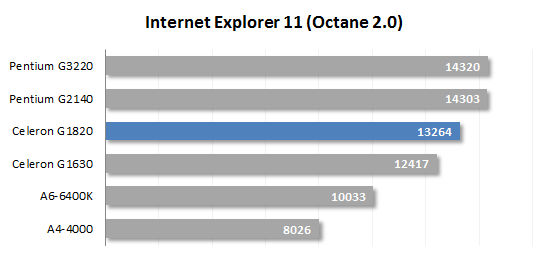Intel has earned fundamental trust among active users desktop gaming PCs, work And computers for home. Reliable and high-performance - this, of course, is about its modern multi-core central processing units . But choosing between AMD And Intel, many of us are faced with very confusing series and names of crystals from the “blue” chipmaker.
This is an instruction on how to understand processors Intel V 2017 what is better in the series Core what characteristics mean model series i3, i5 And i7, and where did they go? Intel Pentium
And Celeron?
What kind of processors does Intel have in 2017?
Modern Intel processors are divided into three types of the Core family.
Intel "Core i" processors differ from each other:
Level cache(own super memory - very important characteristic, which helps the CPU perform tasks more efficiently);
The presence and absence of certain technologies;
architectural decisions;
Goals and your marketing purpose.
Intel Core i3

These are dual-core processors equipped with technology Hyper-Threading. It helps improve performance under high load. It is enough for simple games and most applications under Windows.
Family Intel Core i3 it is not equipped with a large cache, does not support Turbo Boost technology and is most suitable for work and home computers, where the main tasks are related to the Internet, web browsing, light games and office programs.
Intel Core i5

Quad-core processors without Hyper-Threading, but with faster processing of workload-intensive tasks at the physical level. The optimal choice for lovers of games and resource-intensive applications. In terms of performance, they often exceed the capabilities Core i3.
Intel Core i7

Quad-core processors with Hyper-Threading for computer enthusiasts, gamers (for gaming PCs) and professionals. High level of cache memory, advanced integrated graphics technologies and the latest achievements of the company at the core architecture level.
Where did the Intel Pentium and Celeron processors go?
There are practically no old processors left on sale Intel. Series Pentium(for home computers and gaming) and Celeron(working systems) by 2017 were officially transferred from the architectural range to the brand category.

Intel Pentium processors not issued since 2009. Since then this name has been used as a brand for some products entry level based on Intel Core architecture.
Intel Celeron processors finally phased out of commercial production in 2011, giving way to the Atom, Core and in some cases Pentium series.
Everyone thinks that Core i3 is simply cheaper, and Core i7 is more expensive - that’s not true
The well-established opinion that Intel thus segmented its desktop processors into inexpensive ones Core i3, mass medium-budget Core i5 and high performance Core i7 for enthusiasts - not entirely true. The model numbers in each family will completely confuse you.
Can you tell what the difference is between the Intel Core i5-6400 and the Core i5-7600K?
Central processors within the same series may differ in performance levels, different modifications, and even generations. Now we will figure out in a few steps what all these numbers and letters mean. You can immediately determine which processor, for example, Intel Core i5, is better.
What does the number mean in Intel Core processors after i3/i5/i7?

Number 6
in Intel Core i5- 6
400 means generation number (“sixth Intel generation Core"), as 7
in Core i5- 7
600K means 7
generation of Intel processors for Windows 10. This way you can determine which of them is newer and arrange the models in order.
The last three digits determine SKU. They actually show how powerful the processor is within the product line. Core i5-7 600
K will be faster compared to Core i5-7 500
K.
Letters in the name indicate various additional qualities of the Intel Core processor. Here are the differences:
H- high-performance graphics.
K- ability to unlock overclocking of Intel processor.
Q- four physical cores.
QM- the same, but for mobile PCs.
T- Optimized for efficient desktop PCs.
U- optimized with low power consumption for mobile computing.
How to compare Intel, AMD, laptop, PC processors?

There is a universal online service where you can enter the processor model identifier and get a table with a complete comparison of characteristics and features: cpuboss.com.
When choosing laptops, many people pay attention to the processor manufacturer, and this is no coincidence. Two of them, the most popular and used, are AMD and Intel. Both are good, both have their advantages and disadvantages, and both have a right to exist. The main advantage of AMD processors is their quite adequate cost, which is significantly less than that of its competitor. In addition, they are distinguished by fairly broad multitasking, allowing you to simultaneously work with several programs at once, and at the same time operating system works clearly and stably. Among other things, AMD processors can be easily overclocked, increasing performance by about twenty percent.
The disadvantages include the need to install a separate cooler, which would specifically cool the processor itself, and its somewhat worse interaction with the RAM. Among other things, it should be borne in mind that most of all kinds of programs, games and applications are created specifically with Intel in mind, which forces the AMD processor to most often work with programs that are not optimized for it. And the most important thing for laptops is that these processors consume more energy and, as a result, drain the battery faster.
Actually about AMD processor- All. They are cheap (compared to their competitors), provide high level multitasking (very important for many), however they do not provide such power as a competitor and reduce the time battery life laptop.
The positive features of the Intel processor begin with its power, which, if not significantly, then very significantly exceeds that of its competitor. In addition, games, programs and applications optimized for it (and these are the majority) run much faster than with another type of processor. And most importantly, they consume less energy, allowing the battery to “live” longer and thereby increasing the battery life of the laptop.
Disadvantages include low multitasking, which does not allow you to actively work with several applications or programs at once, very high temperatures emitted by the processor, and high cost (compared to its competitor). The last parameter may become critical for a certain number of potential buyers.
Thus, we can conclude that for laptops that are planned to be used for a long time without recharging, it is better to use processors from Intel, but for those for which it is more important that they simultaneously process maximum amount programs or applications, AMD is the best choice. In addition, if the budget is limited, it is preferable to take a processor from AMD, as it is more cheap option, and try to overclock it approximately to the capabilities of the same Intel. On the other hand, especially if you plan to use the device for entertainment with powerful modern games, and the budget for purchasing a laptop is not so seriously limited, then good choice will be a processor from Intel.
 Hello everyone. In fact, the difference between Celeron and Pentium is minimal. But many users may disagree with me, saying that Celeron is much weaker and, in principle, there is some truth here... And all because it was like that before. When there was a 775 socket or an even more ancient 478 socket, then in those days there were basically two families, these were Pentium and Celeron. I don't mean quad-core processors on socket 775, they appeared later.
Hello everyone. In fact, the difference between Celeron and Pentium is minimal. But many users may disagree with me, saying that Celeron is much weaker and, in principle, there is some truth here... And all because it was like that before. When there was a 775 socket or an even more ancient 478 socket, then in those days there were basically two families, these were Pentium and Celeron. I don't mean quad-core processors on socket 775, they appeared later.
So. That's when Celeron was much weaker. But starting with socket 1156, everything began to change, now Celeron is close to Pentium in performance and some users on the forum even advise buying it, since the power is almost the same. But I don’t think so, after all, Penek will be faster... it has 3 MB of cache, and Celeron has 2 MB..
And the whole point is that powerful processors ABOVE Penk appeared in socket 775 (but not immediately, but with the release of new chipsets), even then there were so-called quads, but there was still a difference between Penk and Celeron. But now it is already minimal. Technical process, modern technologies, in general, today's Celeron (1150 socket) is a couple of times more powerful than the old top-end Pentium 4 EE (775 socket), who would have thought...
Therefore, the difference between Penk and Celeron fluctuates around 10-15%, that’s approximately, but not more than 20%, that’s for sure. Basically the same as the price
But it’s true that Celeron has one big plus - it’s actually even cooler, that is, it heats up even less than Penek, and in principle it can be used with passive cooling. But at the same time, you need to think about ventilation in the case, because after all, the Celeron kit comes with a radiator with a fan for a reason.. *cute*
Everything I write here is about the fact that the difference is small, that’s all I mean modern processors starting from socket 1156. I’ll tell you a secret, Celeron G3900, which is 1151 socket, frequency 2.8, 2 MB cache, sixth generation Skylake, well, it will be more powerful than even the quad-core Q9650 on socket 775, although it is the latest Yorkfield core...!
In general, I don’t know what to say. Because my opinion is that the difference in price between a modern Penk and a modern Celeron is exactly equal to their difference in performance. But there are Penka models that can be overclocked, for example the Pentium G3258 model. An overclocked Penek will already be head and shoulders above Celeron, keep this in mind. The price of a model that supports overclocking (that is, having an unlocked multiplier) is 10-15 bucks higher. But it's worth it, believe me...
For example, in this test, Celeron falls just short of Penk’s level:

And believe me, you may not even notice this difference, especially if the computer is intended for the office..
Here is another test and here the same situation will be repeated, the difference is very small:

Another test:

The tests themselves are not particularly important here, the main thing is that the processors here are modern, that is, this is real information in order to understand the difference.
And look here, Celeron 1037U, Celeron J1900, these are processors that are already included in motherboards, that is, soldered, they are not for ordinary computers at all, but for media centers. This is actually why they lose to desktop Celerons:

Here's another WinRAR test (the archiver has a built-in performance test):

Well, I hope that now you already understand that the difference in price is almost the same as the difference in performance. For an office PC or just a home PC, I would take Celeron. If you need a gaming PC, but don’t have a lot of money, then take only a Pentium that can be overclocked, for example, these are the G3260, G3258, G3420 models, these are all 1150 socket. Here's what CPU-Z shows about the G3420:

As you can see here, it’s 4.5 GHz and believe me, this is no longer a joke. And for this you can do without water cooling, it is enough to have a decent radiator with a decent cooler
That's all guys, good luck to you
28.07.2016